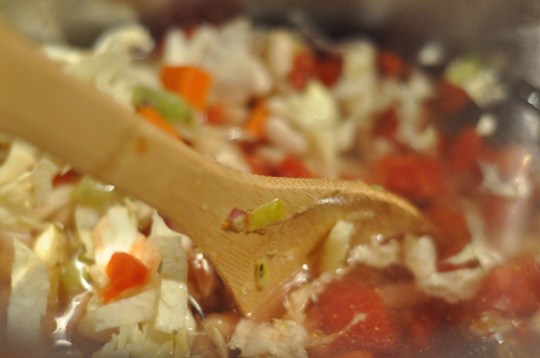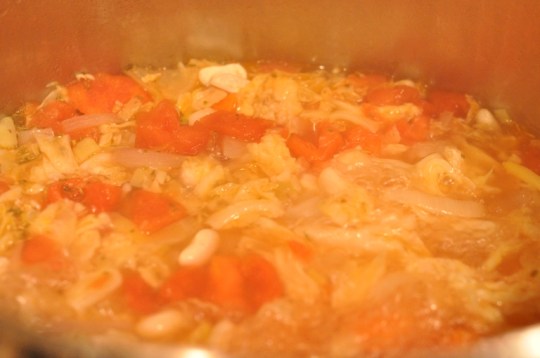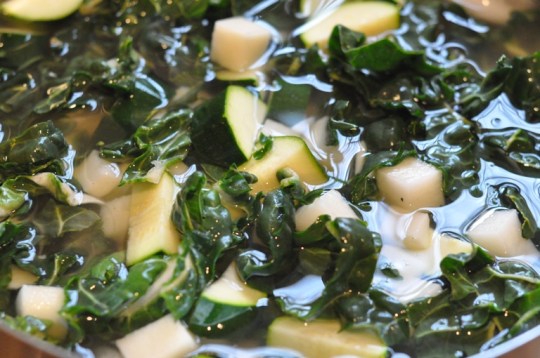Pressure Canning ~ Some Soup Success…Tuscan Minestrone
Okay, after weighing the pros and cons and taking in all of your helpful suggestions, we decided to press on with “operation soup“. It simply is too important to give up at this stage in the game. We read all of your comments and took your advice and altered our pressuring canning methods (slightly) and we’ve had better success. YEAH!!! “Operation Soup” here we come!
RECIPE FOR RIBOLLITA ~ THE TUSCAN MINESTRONE from Sunday Soup
- 8 ounces (1 cup) dried great Northern or cannellini beans (white kidney beans)
- 3 tablespoons olive oil, plus extra for garnish
- 1 cup chopped onion
- 1/2 cup chopped leek, white and light green parts only ( about 1 medium leek)
- 1/2 cup diced carrot (1/2″ diced)
- 1/2 cup diced celery (1/2″ diced)
- 1 tablespoon minced garlic
- 1 teaspoon crushed dried rosemary
- One 14 1/2 ounce can diced tomatoes and their juices
- 8 to 10 ounces Savoy cabbage (from 1 head), halved, cored and cut into 1/4″ wide strips to make 2 1/2 to 3 cups
- 1 1/2 tablespoons kosher salt, plus more if needed
- 8 ounces russet or Yukon gold potato (1 medium), peeled and cut into 1/2″ dice
- 8 ounces zucchini (1 medium), halved length-wise and cut into 1/2″ thick slices
- 6 ounces Swiss chard, stems removed and leaves cut into 1/2″ thick strips to make 2 cups
- 8 1/2″ thick slices day-old Italian bread, such as ciabatta 1 to 2 whole garlic cloves, peeled and halved (we use our crusty Country Loaf)
- 1 cup grated Parmesan cheese, preferable Parmigiano-Reggiano, for garnish
- Rinse the beans and place in a large bowl; cover with 3 cups of boiling water. Soak beans for 1 hour. Drain beans in a colander and reserve.
- Heat olive oil in a large stockpot (lid required) over medium-high heat. When hot, add the onion, leek, carrot, and celery and cook until tender approximately 3 to 4 minutes. Add minced garlic and rosemary and sauté for 1 -2 minutes.

- Add 8 cups water, the reserved beans, tomatoes, cabbage, and 1 1/2 tablespoons salt. Bring the mixture to a boil. Reduce heat and simmer with the lid on for 1 hour.

- Add potatoes, zucchini, and chard; simmer, covered, until the potatoes and zucchini are soft and the chard has wilted, for 20 to 25 minutes. Season the soup to taste with salt and/or freshly ground pepper.

- Ladle the hot soup into the sterilized jars, leaving 1″ headspace at the top.
 Note: sterilizing the jars is not necessary but we’ve gotten into the habit of doing it and this way your jars are also extra clean and nice and hot too.) Use a damp paper towel to wipe the rims of the jars, then put a flat lid and ring on each jar, adjusting the ring so that it’s just finger-tight.
Note: sterilizing the jars is not necessary but we’ve gotten into the habit of doing it and this way your jars are also extra clean and nice and hot too.) Use a damp paper towel to wipe the rims of the jars, then put a flat lid and ring on each jar, adjusting the ring so that it’s just finger-tight.  Place the jars in the pressure canner and follow the pressure canning directions for your area. We pressure canned the soup for 85 minutes. And, left it in the pressure canner to cool to zero pounds of pressure for over 30 minutes.
Place the jars in the pressure canner and follow the pressure canning directions for your area. We pressure canned the soup for 85 minutes. And, left it in the pressure canner to cool to zero pounds of pressure for over 30 minutes.
- Serve the soup with lightly toasted fresh bread slices rubbed with a piece of cut garlic. The bread can be placed on the bottom of the bowl or the top. Sprinkle each cup of soup with freshly grated Parmesan cheese and a swirl of good olive oil. Note: This is done when served…it is not meant to be pressure canned.
Success…or at least a whole lot better than last time. This time 6 out of our 7 jars sealed….and, I can live with that.
Here is what we did differently:
- After letting the pressure canner reach its’ 10 pounds of pressure (the amount of pressure required for a vegetable soup) we reduced the heat. The jiggling gage did not jiggle as much…about 1 to 4 times per minute but not more…and sometimes a little less. Note: This is in accordance to our pressure canners’ instructions…others should follow the instructions/guidelines on their pressure canner to be sure that the proper safety standards are met. We watched to be sure that the pressure was maintained at 10 pounds or slightly higher as it is plus or minus 2 pounds but did not worry too much if the gage didn’t jiggle once every minute…once every two minutes with a little hissing was just fine.
- When our time was up we let it cool to O pounds of pressure and then left it longer (as suggestion made by Gardening in the Borough of NYC). In fact, we did not open the pressure canner for quite a while. It took over 30 minutes for it to cool to zero pounds of pressure and then we probably left it undisturbed (lid on) for another 30 minutes or more. When we opened the pressure canner all but 1 of the 7 jars had sealed and that 7th jar never sealed.
I will record this as a success and enjoy the unsealed jar tomorrow for lunch!
Please note that we double the above recipe to make just a little over 7 x 1 litre jars which is the correct amount for our pressure canner.
Put up Total:
- 7 x 1L regular mouth mason jar ( 1 did not seal and was refrigerated)



You have to either reprocess that batch within 24 hours or throw it away. Quart jars of soup need to be processed for 75 minutes at 10lbs of pressure and then let the pressure drop to zero of its own accord. Furthermore, the weighted petcock needs to be rocking the whole time to ensure that the proper temperature has been maintained. Follow the manufacturer’s instructions on how much rocking is required (some call for a constant, gentle rocking, others for 3-4 jiggles per minute). The process you have described is unsafe for canning low-acid products like soup. Please review the instructions here: http://www.uga.edu/nchfp/how/can_04/soups.html
Thank you for your comment. I am so glad that people are reading these recipes so throughly and that you’ve caught my mistake. Our pressure canner requires that 1 litre or quart jars of soup be processed for 85 minutes (correction made to post) at 10lbs of pressure. Our pressure canning instructions also state, “Do not permit constant jiggling, for this will cause excessive loss of moisture. The occasional jiggle and the hissing sound indicate that you are maintaining the correct pressure.” Please note that it is very important for everyone to follow safety instructions and guidelines for their pressure canner as instructions/guidelines may vary depending on the model, type, and make of pressure canner. Further reading and a great resource on safe canning can be found at http://www.uga.edu/nchfp/how/can_04/soups.html as Mike also states. It is a valuable resource and provides many answers to our questions.
Our problem with pressure canned jars not sealing was that we were taking the jars out once the gauge read zero and have since decided to leave them in a little longer. But, unsealed jars can also be put in the refridgerator and eaten within a couple of days…no need to waste all that hard work. We’ve had 100% success with our last batch of soup and are pleased that “Operation Soup” will continue as planned…
I just re-read your recipe. I’m assuming that the bread is to be served with the soup upon opening. If not, the bread must be omitted or it is not safe for canning, even if you had followed the necessary instructions.
The book we used for this soup recipe was “Sunday Soup”. I outlined her recipe in entirety…but you are correct the bread is not meant to be pressure canned it is to be added when the soup is served. I’ve made this note on this post. Thanks.
Oh Wow! I love that you put greens like chard in your soup. This will be delicious in the winter!
I have read several places that pot milk rice creams etc were not to be canned.
Yes, this is very true. When in doubt I recommend referring to the National Center for Home Food Preservation. It is a wealth of information.
So the recipe as stated above should make 8 quarts?
It made 7 quarts or 7 x 1 litre jars.
How long would pint jars need to be processed?
If you are inquiring about this tuscan minestrone soup recipe (which requires the use of a pressure canner) I would likely do it for around the same amount of time (maybe 10 minutes less).